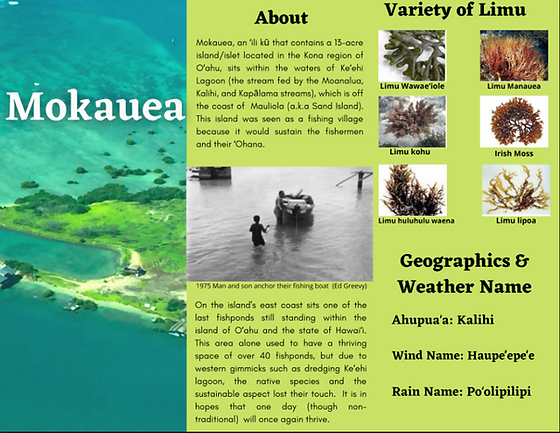
MOKAUEA, KEʻEHI, KONA, OʻAHU

He Kai Ka ʻAnae Ko Keʻehi
The sea for kicking up mullets is at Keʻehi
In the Kona region of Oʻahu, fed by the Moanalua, Kalihi, and Kapālama streams, lies Keʻehi Lagoon. Once a highly productive fishing village, Keʻehi was home to as many as 41 fishponds at its peak. King Kamehameha III, Kauikeaouli, further supported the importance of this area when in 1839, in his written Constitution, he proclaimed Keʻehi as royal fishing grounds under kapu by tax officers of the crown. Keʻehi grounds were very fertile, and many small fishing communities within it existed. ʻAnae, mullet, pakiʻi, flounder, and mūheʻe, squid, were reserved for the Konohiki, or headman of the ahupuaʻa, while other iʻa, fish, and numerous limu, seaweed, and shellfish were bartered or sold to the folks upland. Mokauea Island was once entirely self-sufficient due to its functional fishpond and cultivation of native vegetable and medicinal plants on hand. This was an island that needed nothing more than a consistent environment and respect from others.


In 1972, the State attempted to evict the fisherman from Mokauea and the families were ordered off the island. Several fisherman were arrested for trespassing on the land their families had occupied for generations. In June of 1975, in a final eviction attempt, the State burned down five homes.
In response to these acts, the fishermen organized the Mokauea Fishermen's Association (MFA). The fishermen and their families rebuilt their homes, and the MFA began their work restoring and reviving the fishing village with the cooperation of the Army and groups of students, teachers, scholars, and scientists.
place name
Mokauea: 1) to alight, kau, at the beginning of a path covered with dust, eʻa. 2) broken turtle. 3) a hot wind, Mo, that follows a blast, kau, floating, eʻa, hair such as Pele's; hair floating on a hot wind.

CULTURAL LANDSCAPE
Various fishing techniques were utilized by the people of Mokauea, Keʻehi including puʻolo ʻōpae, imu or umu, loko puʻuone, lay net, and canoe fishing.

Loko Umu
Umu (heap of rocks) are small underwater "houses" that trap fish. Hawaiians made these traps by piling stones loosely into a mound. Seaweed grew on the surface of the stones and that attracted the fish. Water flowed through the umu and the fish would hide inside. Women caught fish by placing a woven net over the opening on one side while shaking a palm frond or stick along the other opening. The fish inside the umu would swim away from the stick or palm and into the net. Umu were not permanent fish traps. People today still use this method to trap fish.
Loko Puʻuone
A loko puʻuone is and isolated shore fishpond named for a puʻuone (a sand dune or heap of sand) that holds water in the pond. the water in the loko puʻuone was braking (wai kai); this meant it was part salt water and part fresh water. Fresh water flowed into the ponds from springs or streams. Salt water flowed in through an opening called an ʻauwai kai. Hawaiians dug the ʻauwai kai to connect the pond to the sea. They built a mākāhā (sluice grate) at one end of the ditch. Small fish swam into the pond through openings in this grate. When the fish got bigger, they couldn't fit through the mākāhā. These trapped fish were caught for food. Some of the loko puʻuone were for makaʻāinana (commoners). Others were built for the aliʻi (chiefs). A loko puʻuone is the same system that can be found on Mokauea.

LImu varieties
Many varieties of limu were harvested and prepared in Keʻehi, amongst them were limu ʻoʻolu, limu manuea, limu lipēpeʻe, limu Kala, limu wawae ʻiole, limu ʻeleʻele.






moʻolelo

Kimona and Makaliʻi
Kimona was a man who had quite the reputation in the valley, for he was quite friendly with manō, sharks. One manō in particular was his friend, Makaliʻi was his name. Makaliʻi was known to live in the channel waters of Moanalua and he too had a reputation for fighting off marauding and hungry manō who attempted to come through the reef and into the waters where iʻa were more abundant. Many stories circulated these two. Kimona was acknowledged as a kahuna who bore a strange fin like mark on his back, stamping him as the shark-man. This man was more than human, he rode sharks and fed them by laying offerings in underwater caves where manō lived. Makaliʻi was beloved by the people of Moanalua and Kalihi, for he would swim up stream far into the valley to Keanakamanō, the cave of the manō, and the people would care for him and feed him. In return, Makaliʻi continued to protect the kamaʻāina, natives of the land, from hungry, man-eating sharks from afar.

stewardship
Today, Mokauea Fishermans Association (MFA) continues to teach community groups through place-based education of the rich history and cultural significance that Keʻehi and Mokauea has to native Hawaiians. Kēhaulani Kupihea, current Program Director of MFA, delights in the kuleana she has to serve her community through the moʻolelo, stories, and traditions of her kūpuna, ancestors. Visiting groups have the opportunity to dive into several different hana, work, including: ʻimiola limu, observation of native limu, kanu, planting native plants, kiloi ʻōpala, marine debris removal, mea kanu komo hewa, removal of invasive species, and mālama loko iʻa, fishpond activities.

_edited.png)




